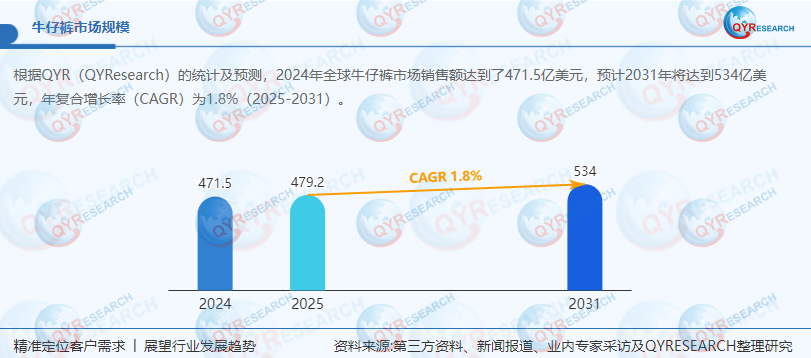According to QYResearch's statistics and predictions, the global denim market sales reached 47.15 billion US dollars in 2024, and are expected to reach 53.4 billion US dollars in 2031, with a compound annual growth rate (CAGR) of 1.8% (2025-2031). At the regional level, the Chinese market has undergone rapid changes in the past few years, with a market size of 11.6 billion US dollars in 2024, accounting for about 24% of the global market. It is expected to reach 19 billion US dollars in 2031, and the global market share will reach 35% by then.
Integrated Innovation: The "National Style Hole" Trend of Jeans

According to the report, sales of jeans featuring the keywords "hole + tie-dye" increased by 210% year-on-year, demonstrating strong growth momentum. Designers have cleverly incorporated the pleating logic of the Song Dynasty's horse-face skirt into the seams of the jeans, combining the holes that originally symbolized labor wear with the ink-wash tie-dye with an oriental charm, achieving a conflicting aesthetic of "destruction" and "leaving blank" on one pair of pants. This design precisely aligns with Generation Z's pursuit of "diverse identities", allowing jeans to no longer be limited to street culture symbols, but to become a "cross-time and space medium" that can be matched with Hanfu tops and button-up shirts, promoting the innovative fusion of traditional elements and modern fashion.
Breaking Barriers: The Evolution of the Class Genes in Jeans
A century ago, denim was used to make pants for gold miners due to its wear-resistant properties. In the Chinese cultural context, jeans have long been labeled as "western", "casual", and even "rebellious". Historical records show that in the late Qing Dynasty, the "clothing ban" strictly restricted the clothing materials of merchants and civilians, and class differences were evident in clothing. In 2025, the average transaction price of jeans on e-commerce platforms was only 218 yuan, with a high coverage rate of consumers aged 18-35, reaching 89%. Designs such as holes, splicing, and oversized versions break the boundaries of class and aesthetics, becoming a visual expression of "de-elitism", making jeans truly achieve the civilian transformation of "everyone can wear".
Women's Power: Gender Examination and Breakthrough in Jeans Consumption
According to the platform's big data, female users contributed 72% of the online sales of jeans, but in the relevant comment section, words expressing body anxiety such as "appearing fat" and "exposing leg shape" appeared at a high proportion of 41%, reflecting the mechanism of "beauty shame" still exists in the field of pants. Faced with this one-way examination, designers introduced the "adjustable hole" design, by concealing zippers at different fabric splices, allowing wearers to independently decide the degree of exposure according to the actual scene, transforming passive "being seen" into active "choosing to see", using a pair of jeans as a carrier to achieve the micro-practice of female body autonomy.
Rapid Spread: The Journey of Jeans from Subculture to Mass Popularity
The communication model shows that after niche jeans styles are exposed on social media, they can complete the whole cycle of "going out of the circle - scale - price reduction" in an average of 180 days. For example, in March 2024, a "ink tie-dye wide-leg jeans" was first released on a short video platform, with more than 2 million likes. By June, the price of the same style on e-commerce platforms dropped to 60% of the original price, and sales exceeded 400,000 pieces, fully verifying the "imitation law" of Tarde. Pioneer groups express their attitudes by wearing niche styles, attracting capital to quickly follow up with mass production. The price reduction promotes widespread participation by the public, making jeans an effective carrier for the democratization of culture.
Green Fashion: The Sustainable Evolution of Denim
An analysis of the current state of the jeans industry reveals that the industry self-regulatory alliance has established a roadmap, aiming to increase the combined proportion of recycled cotton and recycled polyester in the overall denim fabric to 25% by the end of 2025. This initiative is expected to reduce the annual consumption of virgin cotton by 96,000 tons. Numerous brands have introduced "old jeans for new" programs, where consumers can receive a 100 yuan discount coupon for purchasing new jeans by returning their old jeans. The recycled fabric is then treated with ozone fading and laser secondary setting before being reintroduced to the market. The application of environmental protection technology not only aligns with the younger generation's value pursuit of "dressing cool while dressing right," but also drives the jeans industry towards sustainable development.
In summary, the jeans industry in 2025 is undergoing multidimensional changes, ranging from cultural integration, class breakthrough, gender equality, to innovation in communication modes and sustainable development. Jeans are no longer just a type of clothing, but also a cultural symbol that carries the spirit of the times and diverse values. In the future, the jeans industry will continue to write its unique fashion chapter through continuous innovation and transformation.